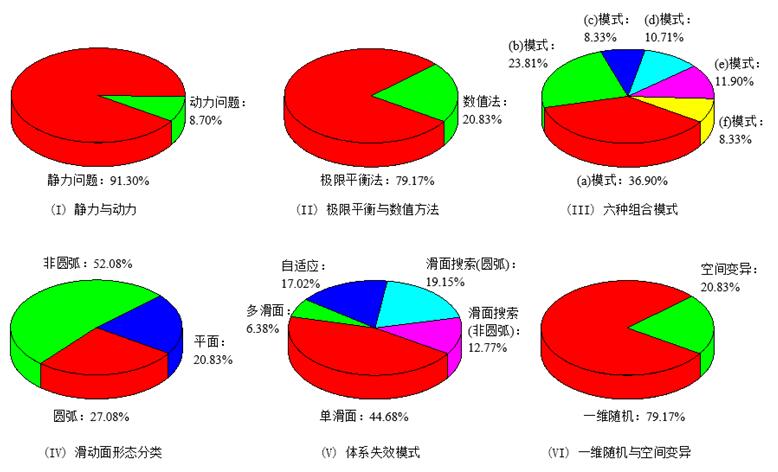[EI论文] 边坡动力可靠性分析方法的模式、问题与发展趋势
作者:
时间:2013-05-10
点击量:
Abastract:
边坡可靠性研究从静力学领域逐步拓展到更具一般性的动力学领域是研究不断深化的必然结果。当前国际上对边坡动力可靠性的研究正处于起步阶段,现有的边坡动力可靠性评价理论和方法均是从静力可靠性理论体系发展而来。通过剖析可靠性问题求解的理论构架,将边坡静力可靠性分析方法分为六种嵌套模式,指出其中四种可以扩展到动力问题。明确了高性能计算在动力可靠性分析中的地位,依据计算复杂性理论对算法的效率做了定量的研究,给出了静力和动力条件下的时间复杂度。对近13年来(2000~2012)SCI-E数据库收录的46篇文献进行了统计分析。在此基础上,将边坡动力可靠性研究存在的问题归纳为三个方面:(1) 对不确定性考虑不足。(2) 边坡体系可靠度求解方法的争论对动力领域的影响显著。(3) 计算效率问题已成为制约动力可靠性研究的技术瓶颈之一。指出未来边坡动力可靠性研究的发展趋势是:(1) 对不确定性的考虑将趋向全面和深入;在岩土体物理力学性质的描述上,运用随机场理论来刻画空间变异性的研究将逐步受到重视;并且,模糊性与随机性将获得深入的整合。(2) 针对边坡体系可靠度求解方法的争论,今后的发展方向之一是致力于从理论上实现完备的证明,结束关于边坡体系可靠度求解方法的争论;方向之二是在具体实践上,将朝着精细化、复杂化的方向发展,将会更为广泛地与新兴的群体智能优化算法相结合。(3) 在解决动力可靠性分析的计算效率问题上,以Monte Carlo法内嵌响应面法的模式具有良好的发展前景,通过吸收非线性学科的相关优秀算法作为高效率的响应面代理手段,将会极大地推动边坡动力可靠性研究的发展。
The evolution of slope reliability research from statics to even more universal dynamics is an inevitable result of its development. At present, the research on dynamic reliability of slope is in its infancy, and the available evaluation theory and methods are evolved from the static reliability theoretical system of slope. Based on the analysis of the theoretical framework of a reliability problem, the methods of static reliability analysis were divided into six nested modes, four of which are compatible with the dynamic reliability problems. This paper clarifies the significance of the high-performance computing in reliability analysis. A quantitative study of the efficiency of the algorithm was achieved based on the theory of computational complexity. The time complexities of these six modes were proposed under static and dynamic conditions. Based on the statistical analysis of 46 SCI-E citations within 2000~2012, the problems of present slope dynamic reliability research were summarized into three aspects: (1) The consideration of uncertainty is inadequate. (2) The controversy regarding slope system reliability methods has a significant effect on the dynamic field. (3) Computational efficiency has become one of the technical bottlenecks of restricting the further study of dynamic reliability. Correspondingly, the future development trend can be summarized as follows: (1) Consideration of uncertainty will trend to more comprehensive and in-depth methodology. The use of random field theory to characterize the spatial variability of physical and mechanical properties of the rock and soil will gradually be given more serious attention. In addition, the fuzziness and randomness will receive in-depth integration. (2) Addressing the controversy issue of slope system reliability methods, a strong proof of theory is desired. In future practice, more precise and more complicated approaches as well as the emerging swarm intelligence optimization algorithms will be widely used. (3) For the issue of computational efficiency for dynamic reliability analysis, the embedded mode that combines response surface method and Monte Carlo simulation method has an excellent prospect of developing. By using the appropriate and excellent algorithms from nonlinear disciplines as a high-efficiency surrogate for the response surface, the development of the slope dynamic reliability research will be greatly promoted.
Keywords:
边坡;滑坡;可靠性;评价方法;动力;模式分类;发展趋势
Slope;Landslide;Reliability;Evaluation method;Dynamic;Pattern classification;Development trends
 |

